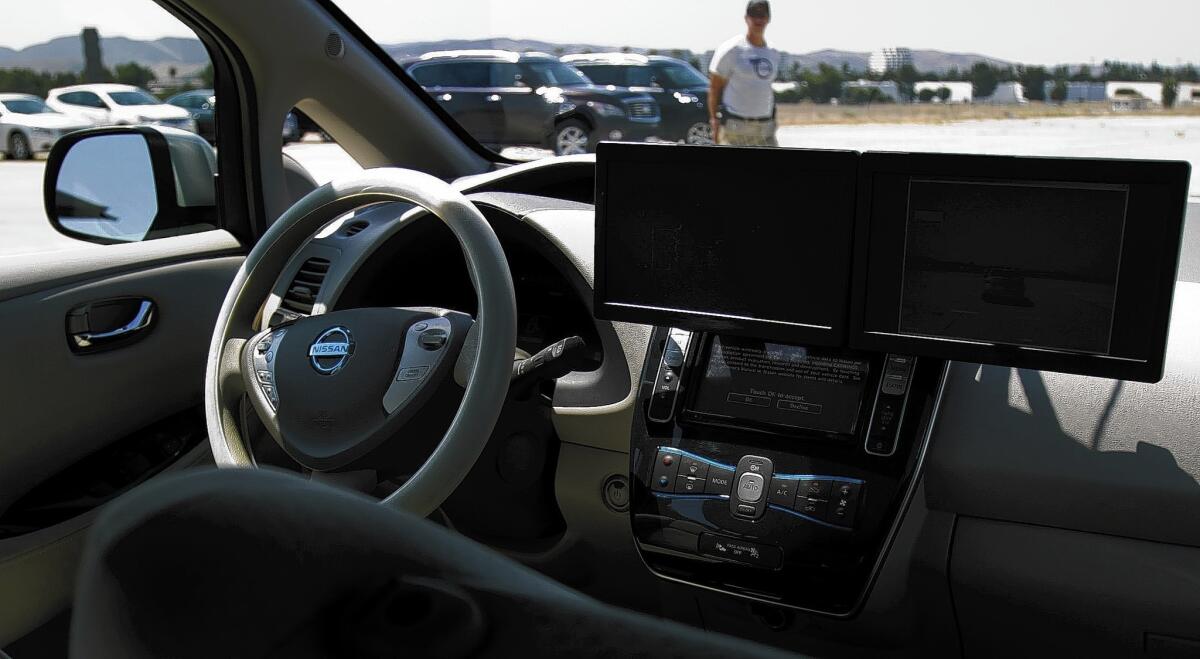Proposed rules for self-driving cars drafted by California regulators

- Share via
SACRAMENTO — California regulators are speeding ahead with new rules of the road for testing and eventually operating self-driving cars — autos that can function without someone actively at the controls. Manufacturers hope these cars may be available by 2020.
The Department of Motor Vehicles last week announced it has drafted proposed rules for so-called autonomous cars. The regulations, when final in the spring, would govern testing procedures that manufacturers would use to develop the cars as early as a year from now.
“They’re right on track,” said state Sen. Alex Padilla (D-Pacoima), the author of a 2012 law that began the process for making such cars legal. California is the furthest along of three states — the other two are Nevada and Florida — working on regulations. The California requirements deal with insurance, reporting of road-test results, safety and other issues.
The idea of self-driving “conjures up images of Buck Rogers and futuristic things,” said Bernard Soriano, a DMV official in charge of the program. “But, it’s not far off. When we meet with the manufacturers, we realize that technology is not the limiting factor.”
Manufacturers want to test in California, he said. “We’re a big state with a wide variety of terrain ... a lot of people, a lot of roads and a lot of situations that cars will have to encounter.”
Greenhouse gas progress
The Golden State is gaining ground in the battle to cut greenhouse gas emissions, such as carbon dioxide, that contribute to global warming.
That’s the takeaway from a hearing held last week at UCLA by the state Senate’s Select Committee on Climate Change and AB 32, the landmark 2006 law that requires a 17% drop in greenhouse gas pollution by 2020.
California is more than halfway toward meeting the goal, but there is much to do, said the law’s author, Sen. Fran Pavley (D-Agoura Hills).
“It’s going to require a concerted effort by the public and private sectors,” she said. “And the focus should be not just on emission reductions but the adaption of people to a warmer climate.”
Jobless angst
For many of California’s jobless trying to get overdue unemployment benefits as the holidays approach, the nightmare at the Employment Development Department goes on.
Just ask laid-off aerospace welder Robert Rowe, 56. He griped that phone calls and emails to the agency have gone unanswered and benefits have come weeks late. “It’s insane,” he said. “You feel like a dog chasing your tail.”
The EDD for months has been plagued with a glitchy computer upgrade that delayed payments to about 150,000 claimants. The backup has been largely fixed, the EDD contends.
Frustrated by the bureaucracy, Rowe wrote the Los Angeles Times to say, “I am desperate.” Last week, a Times reporter passed the complaint to an official of Gov. Jerry Brown’s administration.
That same day, the EDD called Rowe, telling him his money was in the mail. The quick response, said an EDD official, was “coincidental.”
Twitter: @MarcLifsher
More to Read
Inside the business of entertainment
The Wide Shot brings you news, analysis and insights on everything from streaming wars to production — and what it all means for the future.
You may occasionally receive promotional content from the Los Angeles Times.











